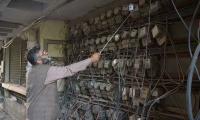HYDERABAD: Cattle farmers and traders are at the end of their tethers as the government is yet to take a decision regarding reopening of livestock markets in Sindh province, which not only provide subsistence to thousands, but also add to the rural economy, just like other sectors of economy.
After providing relief to people and traders associated with agriculture and fisheries sectors, the government had allowed all markets to do business “conditionally” to save the country’s economy.
Livestock is the second largest sector, which provides source of livelihood to a large number of people in rural areas, who depend on animal rearing, selling milk and other dairy products for livelihood. But the cattle markets are still closed for trading, which may push these people deeper in the economic quandary.
Livestock is an integral part of agriculture sector, which contributes to GDP big time. The livestock not only plays a role in economic activities among rural people but is also a source of nutritious diary products like milk, butter, yogurt, and others.
Muhammad Siddiq, associated with Rural Development Association (RDA) in Mithi, Tharparkar district, said usually there were small scale weekly cattle markets in desert towns, which would attract herders and traders to sell and purchase animals.
“Small animals are considered easy for the poor workers to sell, whenever they need to run domestic affairs. The people of Tharparkar district, who face frequent droughts and dryness, due to shortage of rainfall and unavailability of drinking water, consider livestock as a valuable asset, which provides source of income and nutrition,” Siddiq said.
He said the recent COVID-19 outbreak-led lockdown disturbed all the cattle markets and businesses related to this major sector.
“All markets have conditionally been opened to relieve the people associated with them. Why are cattle markets being made an exception?” he questioned.
A large number of people in Tharparkar, Umerkot and Sanghar’s Achhro Thar (white desert) areas kept animals to sell them when they have to purchase wheat stock for the whole year, he said and added with remorse, but this time around they could not avail this opportunity.
He said at least 75 percent people depended on livestock rearing in Thar desert. “There are a few families that usually depend on rain for agriculture in the desert area, who also have herds of animals to earn little income for survival.
Tharparkar district have 6 million livestock population, including small and large animals.
After closure of cattle markets in Tharparkar district all cattle farmers are worried about their future, as they do not have any other option to survive.
Besides, this, there is a popular trend in Tharparkar district that common people invest to keep animals at homes to sell them on the occasion of Eidul-Azha to earn enough income.
It was observed that some needy farmers wanted to sale their animals at low rates to fulfil the domestic needs. Because they do not have any option due to closure of cattle markets.
Similarly, Siddiq said the rates of milk has also been witnessed declined in desert areas during lockdowns. The poor farmers were forced to sell milk at 1 kg per Rs20—25 only in desert areas, because all restaurants, tea stalls and sweetmarts were closed following the lockdown.
Ramzan Nangraj, one of the leading cattle traders from Naushehro Feroz district said these local markets were considered main sources of cattle traders to keep stock of popular breeds for business on the occasion of Eid-ul-Azha.
Nangraj said mostly traders from Sindh brought popular breeds from Punjab province during the month of Ramazan for selling them on Eid-Ul-Azha. “But this time, though the animals are available in some parts of Punjab markets, traders seem reluctant to take risk after the fear of Coronavirus and closure of business activities in the entire country.
Dr Abdullah Sethar, Registrar Livestock Breeding Service Authority, Sindh Livestock and Fisheries department calls it devastation to business activities not only for a person or family but the national economy will also suffer. “Because sale and purchase is the main economic activity in livestock market, which also benefits the government to receive tax through this specific trade.”
Dr Sethar believes that now when all markets have been opened conditionally, why the people associated with this sector are being deprived of the benefit.
“It may cause economical loss to the common people as well as the government itself in case of continue closing cattle markets,” Dr Sethar said.
He said the small-scale cattle markets were the sources of supplying young and healthy animals for slaughtering in urban areas. “This definitely will impact on price hike of daily use items in future,” he added.
Similarly, cattle farmers in suburbs of Hyderabad could not get reasonable rates of milk during the lockdown situation, because people refused to use milk, fearing they or their families may not catch COVID-19. In result, these milk sellers were compelled to sell milk at Rs40-50/kg, compared to Rs80—100 in normal days. In this situation they faced huge loss.
The situation on the ground is not good at all from the first day of the lockdown as an abrupt closure of markets took the herders and traders off guard. Now with losses piling up with every passing day, cattle farmers call for immediate measures to help them get back on their feet, before a total collapse.
A trader works on the floor of the New York Stock Exchange , New York City. — AFP/FileNow that US interest rates...
A general view of al-Atba district of the Egyptian capital Cairo. — AFP/FileCAIRO: Egypt appears on track to break...
A man selling vegetables waits for customers at his makeshift stall at Empress Market in Karachi. — ...
A woman shops in a wet market in Kuala Lumpur, Malaysia. — Reuters/FileKUALA LUMPUR: Malaysia's economy grew faster...
The Pakistan Business Forum logo. — Facebook/pbf.limitedISLAMABAD: The Pakistan Business Forum on Saturday called...
US dollar banknotes are seen in this illustration taken March 10, 2023. — ReutersKARACHI: The government plans to...







